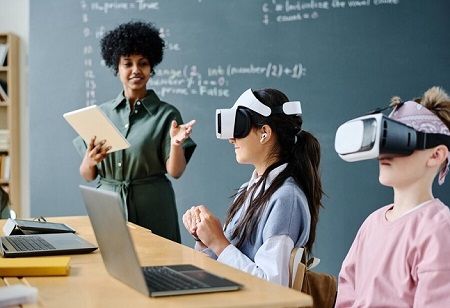When we talk of better and technology-driven education the first thing that comes to our mind are Augmented Reality and Virtual Reality. Every student wants to understand the concepts behind the theories rather than just memorizing them. With the traditional education pattern, it was very difficult for the students to grasp the concept but in modern education where there is a flood of technology, the education system is also reforming itself with technologies like Virtual Reality. The global Virtual Reality market has grown from approx. 6.3 billion dollars in 2021 to 38.6 billion dollars in 2024. The market is expected to grow at the rate of 10.7 percent annually till 2028 and reach a market of 58.1 billion dollars. Approx. all students and teachers are interested in bringing and using new VR technology in classrooms. Let's delve into the article and see how Virtual Reality is changing the lives of Students and teachers.
How Students Are Using Virtual Reality to Understand Things Better?
As we go back to our old days and compare to the traditional style of reaching where students had to learn from books and big-sized computers, the new technology of Virtual Reality helps students to learn concepts more quickly and understand them closely. Let's take the example of chemistry class, in our days how we used to do experiments in labs with proper care wearing aprons and using gloves but still acting out of fear that we might come in contact with the chemicals accidentally. But with the help of Virtual Reality, we can explore these fields with confidence and dive in to learn more and more concepts easily and without fear of the dangers associated with the real world.
Also, schools allow students to learn concepts sitting at home. Remember the days when you were not able to attend classes due to some injury and missed them and there was the burden of asking for notes, any of your classmates were not able to attend classes because they met an accident. These problems are now not more hindrances in the path of learning.
Recall those geometrical concepts and the figures that were difficult to visualize in mind. Circles, Spheres, Pentagons, Polygons and many more figures were not so easy to understand, but with the use of VR technologies, students can check 3D figures; they can rote the structure, understand and get a very clear picture of angles, vertices, edges etc. Students can also get the information and the experience of visiting different places and understand the culture of other places without going anywhere outside, just by sitting in their classroom. School tours and excursions were very expensive for some of the students which is not the case in today's VR-equipped education system.
The atomic structure was the most difficult concept to understand even the most brilliant students were not able to explain the concepts of the atom and its particles like the nucleus, electron, proton and other elements. But with Virtual Reality, Students can not only understand those concepts but they can apply those concepts in real life.
How Academies are Helping Students to Learn Concepts Using VR?
Tohoku University in Japan recently collaborated with the world's largest Metaverse platform VRChat to enhance online learning through Metaverse and Virtual Reality. Students can engage with their international peers with the help of head-mounted displays (HMDs). Masako Hayashi, an associate professor has been using Virtual Reality technology in her classroom since 2021. Last winter, students were asked to create a virtual world featuring the cultural aspects of the country. Hayashi said that the HMDs are very helpful in providing more immersive and realistic views to the students. Alisha Yoshida, a student from America who was a member of Hayashi's class created a virtual world around the theme of music with her friends.
Nanyang University of Technology in Singapore recently introduced a new method to track human movements of the human through Virtual Reality technologies. Students will be able to enhance their AI and analytical skills, and the integration of science with technology will help to solve the practical problems of the future. The university will launch a 4-year degree program to implement technology-enabled learning using virtual and augmented reality.
A recent study at Central China Normal University shows that students get opportunities to practice and improve their social and emotional skills when they are alone. According to the survey conducted by the university, approx. 70 per cent of teachers want to use Virtual Reality technology in schools. They said that VR technologies are very helpful in teaching social skills and empathy to students.
Sandeep Dham, Chief Operating Officer, Aakash BYJU’S highlighting Virtual Reality in education says, "Augmented Reality and Virtual Reality technologies are opening up new frontiers in creating a rich learning experience that is more immersive and advanced. Using 3D videos and 3D simulations elevates learning of Math and Science concepts. It is more than just what the person sees but how they see it."
Conclusion
Virtual Reality has the capability and power to change the whole education system and way of teaching. From primary to tertiary education, whether it is math or social science, VR has the reach and involvement in every aspect of teaching. When more teachers and students become familiar with the technology then automatically the demand for using VR technologies in school will rise in future. As we have seen in the article how different schools and governments are taking steps to incorporate VR technologies. In the coming years, this technology will expand throughout the globe and will completely change our perspective towards education.

